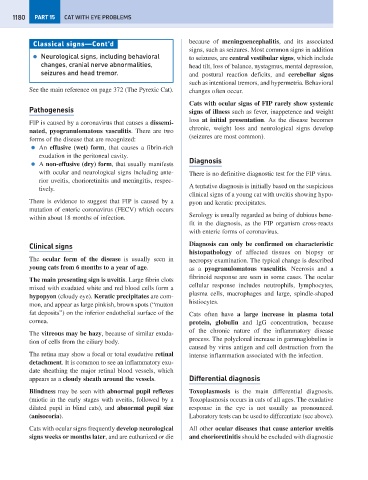Page 1188 - Problem-Based Feline Medicine
P. 1188
1180 PART 15 CAT WITH EYE PROBLEMS
Classical signs—Cont’d because of meningoencephalitis, and its associated
signs, such as seizures. Most common signs in addition
● Neurological signs, including behavioral to seizures, are central vestibular signs, which include
changes, cranial nerve abnormalities, head tilt, loss of balance, nystagmus, mental depression,
seizures and head tremor. and postural reaction deficits, and cerebellar signs
such as intentional tremors, and hypermetria. Behavioral
See the main reference on page 372 (The Pyrexic Cat). changes often occur.
Cats with ocular signs of FIP rarely show systemic
Pathogenesis signs of illness such as fever, inappetence and weight
loss at initial presentation. As the disease becomes
FIP is caused by a coronavirus that causes a dissemi-
chronic, weight loss and neurological signs develop
nated, pyogranulomatous vasculitis. There are two
(seizures are most common).
forms of the disease that are recognized:
● An effusive (wet) form, that causes a fibrin-rich
exudation in the peritoneal cavity.
Diagnosis
● A non-effusive (dry) form, that usually manifests
with ocular and neurological signs including ante- There is no definitive diagnostic test for the FIP virus.
rior uveitis, chorioretinitis and meningitis, respec-
A tentative diagnosis is initially based on the suspicious
tively.
clinical signs of a young cat with uveitis showing hypo-
There is evidence to suggest that FIP is caused by a pyon and keratic precipitates.
mutation of enteric coronavirus (FECV) which occurs
Serology is usually regarded as being of dubious bene-
within about 18 months of infection.
fit in the diagnosis, as the FIP organism cross-reacts
with enteric forms of coronavirus.
Clinical signs Diagnosis can only be confirmed on characteristic
histopathology of affected tissues on biopsy or
The ocular form of the disease is usually seen in necropsy examination. The typical change is described
young cats from 6 months to a year of age. as a pyogranulomatous vasculitis. Necrosis and a
fibrinoid response are seen in some cases. The ocular
The main presenting sign is uveitis. Large fibrin clots
cellular response includes neutrophils, lymphocytes,
mixed with exudated white and red blood cells form a
plasma cells, macrophages and large, spindle-shaped
hypopyon (cloudy eye). Keratic precipitates are com-
histiocytes.
mon, and appear as large pinkish, brown spots (“mutton
fat deposits”) on the inferior endothelial surface of the Cats often have a large increase in plasma total
cornea. protein, globulin and IgG concentration, because
of the chronic nature of the inflammatory disease
The vitreous may be hazy, because of similar exuda-
process. The polyclonal increase in gammaglobulins is
tion of cells from the ciliary body.
caused by virus antigen and cell destruction from the
The retina may show a focal or total exudative retinal intense inflammation associated with the infection.
detachment. It is common to see an inflammatory exu-
date sheathing the major retinal blood vessels, which
appears as a cloudy sheath around the vessels. Differential diagnosis
Blindness may be seen with abnormal pupil reflexes Toxoplasmosis is the main differential diagnosis.
(miotic in the early stages with uveitis, followed by a Toxoplasmosis occurs in cats of all ages. The exudative
dilated pupil in blind cats), and abnormal pupil size response in the eye is not usually as pronounced.
(anisocoria). Laboratory tests can be used to differentiate (see above).
Cats with ocular signs frequently develop neurological All other ocular diseases that cause anterior uveitis
signs weeks or months later, and are euthanized or die and chorioretinitis should be excluded with diagnostic

